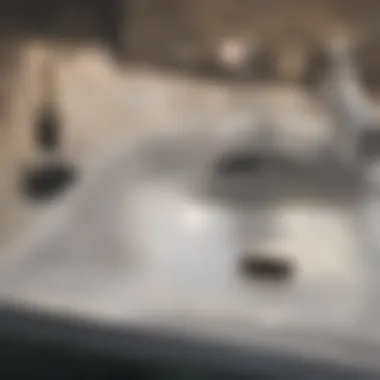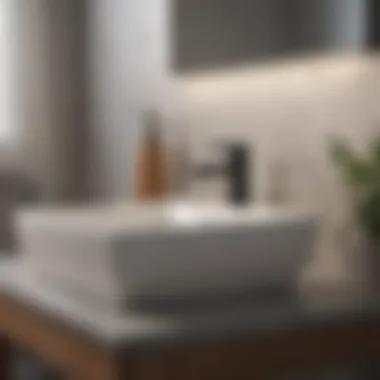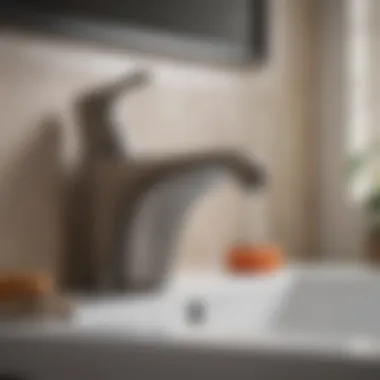Understanding Blocked Bathroom Sinks: Causes and Solutions


Intro
Blocked bathroom sinks are a frustrating issue that many homeowners face. Often, the cause is not immediately apparent. This article takes a closer look at the various factors that can lead to a clogged sink, the diagnostics you can perform, and the solutions available. Additionally, it offers insight into preventive measures to help keep your bathroom sink flowing smoothly. By understanding these elements, homeowners can sustain both the functionality and aesthetics of their living spaces.
Feature Spotlight
Causes of Blockage
Understanding the causes of sink blockages is the first step toward effective solutions. Common culprits are hair, soap residue, toothpaste, and other debris. Over time, these materials accumulate and form clogs. In some cases, the issue may stem from problems within the plumbing system itself, such as damaged pipes or improper installation. Thorough knowledge about the sources of blockage allows for a more targeted approach to solving the problem.
Diagnosing Issues
Once a blockage is suspected, diagnosing the issue becomes essential. Start by observing how water drains. If it gurgles or drains slowly, the problem is likely a partial blockage. Sometimes, a visible inspection of the drain can reveal hair or debris. For more complicated issues, consider using tools such as a plumber's snake or a wet-dry vacuum.
Tip: Regular maintenance can prevent extensive blockages. Consider removing debris from the drain cover periodically.
Solutions for Blocked Sinks
When faced with a blockage, there are several approaches to consider. For minor clogs, a mixture of baking soda and vinegar can often provide relief. Pour half a cup of baking soda down the drain, followed by half a cup of vinegar. Allow it to sit for 15-30 minutes before flushing with hot water.
If you are dealing with a more stubborn blockage, using a plunger is advisable. This method can create the necessary pressure to dislodge the clog. For severe cases, it may be wise to consult a professional plumber to assess the situation thoroughly and recommend the appropriate action.
Prevention Methods
To minimize the chances of future clogs, implementing preventive measures is crucial. Here are several strategies:
- Install a drain strainer: This simple device can catch hair and debris before they enter the plumbing system.
- Regular cleaning: Regularly clean the drain and surrounding area to prevent buildup.
- Be mindful of what goes down the drain: Avoid washing oily substances, large food particles, or items that do not dissolve in water.
By integrating these methods into your home maintenance routine, you can effectively reduce the risk of encountering blocked drains in the future.
This article will continue to delve into practical advice on maintaining bathroom sinks, ensuring their optimal performance in your home.
Intro to Bathroom Sink Drainage Issues
Bathroom sink drainage issues are a common yet often overlooked concern in many households. Proper drainage is essential for maintaining hygiene and preventing water damage to your property. When a sink fails to drain efficiently, it can lead to a frustrating experience and potential plumbing mishaps. Understanding the factors behind these blockages is the first step in addressing the problem effectively.
Importance of Proper Drainage
Ensuring that bathroom sinks drain correctly is crucial for several reasons. Firstly, stagnant water can create an environment conducive to mold and mildew growth, posing health risks over time. Secondly, an inefficient drainage system can lead to unpleasant odors, harming your bathroom’s ambiance. Moreover, persistent drainage issues can escalate to more severe plumbing problems, potentially resulting in costly repairs. Thus, recognizing the importance of proper drainage not only enhances usability but also preserves the structural integrity of your home.
Signs of a Blocked Sink
Detecting a blocked sink early can mitigate further complications. Common signs indicating blockage include slow draining water, unusual sounds during drainage, or standing water in the basin. You may also notice unpleasant smells wafting from the sink, suggesting organic material buildup within the pipes. Another clear indicator is when water backs up in the sink, which often signifies a more serious blockage downstream.


"Being attentive to the early signs of blockage can save time and prevent costly plumbing repairs later on."
In summary, understanding bathroom sink drainage issues lays the foundation for effective maintenance. It is essential to identify not just the causes and symptoms but also the methods to prevent such problems in the future.
Common Causes of Sink Blockage
Understanding the common causes of sink blockage is crucial for homeowners seeking to maintain a functional bathroom. When a sink drains slowly or not at all, it can disrupt daily routines and deter from the overall aesthetics of the space. By identifying specific causes, you can develop effective solutions tailored to your situation. Familiarity with the origins of clogs can minimize future inconveniences and expenses associated with plumbing services.
Hair Accumulation
Hair is among the most frequent culprits causing bathroom sink blockages. Over time, strands of hair can accumulate in the drain. This build-up often combines with soap residue and other elements, creating a dense mass that effectively chokes the drainage system. In households with multiple members, especially where long hair is common, the problem can intensify. Regular maintenance and preventive measures such as frequent cleaning can help keep hair from becoming a significant obstruction.
Soap Residue and Mineral Buildup
Soap can contribute to sink blockages not only by its physical presence but also when it interacts with minerals in the water. This creates a sludge-like substance that clogs pipes. Hard water, prevalent in many areas, carries minerals like calcium and magnesium. The combination of soap scum and mineral deposits can lead to severe drainage issues, especially over time. Utilizing milder soaps and regularly clearing drains can mitigate build-up.
Foreign Objects
Foreign objects inadvertently finding their way into the sink can lead to abrupt blockages. Items such as dental floss, cotton swabs, or small toys often slip down, causing significant issues. Even seemingly innocuous objects can halt drainage. Gaining awareness about what should not go down the sink is vital. A drain cover can play an essential role in preventing such mishaps.
Pipe Damage or Misalignment
Physical damage to pipes or misalignment can restrict water flow. Over time, pipes can corrode or suffer from pressure leading to crumbling, cracks, or misalignment. Even inappropriate installation can result in drainage issues. Regular inspection of these components, alongside timely repairs, can prevent significant blockages and costly repairs later.
Grease and Oil Clogs
In bathrooms, as opposed to kitchens, grease accumulation might not be significant, yet it can still occur. Personal care products, such as lotions or oils, when rinsed off, can solidify and contribute to clogs. Particularly in homes where such products are frequently used, this remains a noteworthy consideration. Opting for proper disposal instead of rinsing down the sink is a beneficial practice to prevent unintended blockages.
Key Insight: Awareness of these common causes empowers homeowners to act proactively rather than reactively to drain issues. Identifying specific causes can lead to tailored solutions and ultimately a better-maintained home.
Diagnosing the Problem
Diagnosing the problem of a blocked bathroom sink is a critical step in maintaining both the functionality and aesthetics of a home. Understanding the specific issues at play allows homeowners to select the most effective solutions, potentially saving time and money. This section will delve into various diagnostic methods, providing a structured approach to identifying the root causes of sink blockages. Proper diagnosis can also prevent future occurrences by enabling homeowners to develop more informed maintenance practices.
Visual Inspection Techniques
Visual inspection is the first line of defense in diagnosing a clogged sink. It involves examining various components of the sink and the plumbing system for visible signs of blockage or damage. Here are some techniques that can be employed:
- Check the Sink Basin: Look for any pooling water or unusual slows in drainage that might indicate a blockage.
- Inspect Fixtures: Examine the faucet and handles for leaks or corrosion, which can indicate underlying pipe problems.
- Look under the Sink: Inspect the area beneath the sink for any signs of moisture or leaks. Water stains can indicate issues that may require immediate attention.
A thorough visual inspection can reveal immediate problems that might be causing the blockage. Ensuring that everything appears in good shape will provide insights into whether additional measures are needed.
Using a Plunger Effectively
Using a plunger is a practical and straightforward way to address minor blockages. However, effectiveness comes from applying the right techniques.


- Choose the Right Plunger: Use a flange plunger, as it is designed specifically for sink and drain applications.
- Ensure a Seal: Cover the overflow hole with a wet cloth, if available. This helps to create a vacuum and allows for better suction.
- Position the Plunger: Place the plunger over the drain and press down gently, creating a mass of air:
- Check the Drain: After plunging, run some water to see if it drains properly.
- Pull up quickly to generate suction.
- Repeat this motion for several minutes.
Employing a plunger can be highly effective if the blockage is not too deep within the plumbing. Regular use in response to drainage issues can also help to prevent future clogs.
Assessing Pipe Conditions
Assessing the conditions of the pipes is an essential aspect of diagnosing sink problems. Understanding whether the pipes are compromised can lead to a quicker resolution of the blockage. Here’s how to do it:
- Slickness and Stains: Feel the outside of the pipes. If they feel slick or have stains, this could indicate grease buildup or corrosion.
- Listen for Sounds: Turn on the faucet and listen. Gurgling sounds may suggest air is trapped within the system, which can be a sign of a blockage.
- Examine Pipe Joints: Check the areas where pipes connect. Loose joints can lead to leaks that contribute to a blockage.
Regular assessment of pipe conditions should be part of any home maintenance routine, allowing for early intervention before small issues escalate into larger headaches.
Methods to Clear the Blockage
Blocked bathroom sinks are common nuisances that can disrupt daily routines. Therefore, addressing this issue effectively is crucial for maintaining an efficient home environment. Understanding various methods to clear the blockage enables homeowners to take proactive measures, ensuring their sinks function properly. Each method has its advantages, which range from cost-effectiveness to ease of implementation.
Basic Tools for DIY Solutions
When tackling minor sink clogs, having the right tools can make a significant difference. Here are some basic tools that can aid in clearing blockages:
- Plunger: A simple but effective device that creates suction to dislodge most clogs.
- Drain Snake: This tool can navigate through tight spaces in pipes, reaching clogs that a plunger cannot.
- Bucket: Useful for catching any water that may spill during the unclogging process.
- Gloves: Protect your hands from debris or harsh chemicals.
- Flashlight: Helps identify the location of the clog within the pipe.
These tools are often readily available at home improvement stores or even within your own home. Using these tools can empower homeowners to attempt clearing clogs without immediate professional assistance.
Homemade Drain Cleaners
Many homeowners prefer homemade drain cleaners for their effectiveness and environmental safety. These cleaners can be created using basic household ingredients. One common method involves:
- Baking Soda and Vinegar: Pour half a cup of baking soda down the drain, followed by half a cup of vinegar. Let it fizz for about 30 minutes, then flush with hot water. This combination can help break down minor clogs.
- Salt and Baking Soda: A mixture of salt and baking soda can also serve to dissolve build-up in the pipes. Pour equal parts down the drain and follow with hot water after a few minutes.
Homemade solutions may not address severe blockages but can effectively assist in routine maintenance.
When to Use Chemical Drain Cleaners
While homemade solutions are often effective, there are situations when it might be appropriate to consider chemical drain cleaners. These products can dissolve tougher clogs caused by grease, hair, or soap buildup. However, they should be used sparingly due to their potential to damage pipes and be hazardous if not handled properly. Here are some considerations:
- Read the instructions carefully and follow safety precautions.
- Avoid mixing different chemicals as this can create toxic fumes.
- Do not use chemical cleaners on older pipes or fixtures that may be prone to damage.
Chemical cleaners can provide a quick fix, but caution is advised to prevent long-term issues.
Disassembling the P-Trap
In some cases, the blockage may be located in the P-trap, a curved pipe under the sink designed to trap debris. Disassembling the P-trap can provide direct access to the clog. Here’s how to do it:


- Place a bucket underneath the sink to catch water and debris.
- Use a wrench to loosen the slip nuts connecting the trap to the sink and the wall pipe.
- Carefully remove the P-trap and check for clogs.
Cleaning or replacing the P-trap often resolves persistent drainage issues. However, it requires some mechanical skill and caution to avoid making the situation worse.
Professional Plumbing Services
When faced with complex blockages or persistent issues, it may be time to consult professional plumbing services. Licensed plumbers have the experience and tools to diagnose deeper issues that homeowners might not be able to see. Benefits of hiring professionals include:
- Comprehensive assessment of drainage systems.
- Use of specialized equipment such as hydro-jetting.
- Long-term solutions to prevent future clogs.
While hiring a plumber incurs costs, it is often worth it for the peace of mind and expertise they provide.
Seeking professional help can save time and prevent further damage to plumbing systems.
Long-term Solutions and Maintenance
Understanding the long-term solutions and maintenance for your bathroom sink is essential. Blocked sinks can lead to significant inconveniences and expenses. By implementing strategic maintenance practices, homeowners can greatly reduce the likelihood of clogs and the subsequent need for expensive repairs. Regular care not only ensures functionality but also enhances the overall longevity of your plumbing system.
Regular Cleaning Practices
One of the most effective preventive measures is establishing regular cleaning practices. This includes running hot water through the sink after each use. It helps flush away any soap residues or food particles that may settle in the pipes. Additionally, consider using a vinegar and baking soda mix as a natural cleaner. Pour half a cup of baking soda followed by half a cup of vinegar down the drain. Wait for 15 minutes, then rinse with hot water. This combination effectively breaks down any minor buildup in your drainage system.
Installing Drain Covers
Another practical solution is the installation of drain covers. These devices prevent hair, soap, and other debris from entering the drain. A good drain cover can significantly minimize the amount of waste that accumulates over time. When selecting a drain cover, choose one that is easy to remove and clean. Keeping it free of accumulated debris is crucial for optimal drainage performance. Regularly cleaning your drain cover can keep flow uninterrupted and reduce blockage risks.
Proper Disposal of Waste
Proper disposal of waste is essential to maintaining a clear sink. Avoid rinsing items like food particles, grease, or sanitation products down the sink. Instead, use a waste bin for these items. People often forget that certain materials do not break down in water. Grease, in particular, can solidify and create stubborn blockages. Educating household members about proper waste disposal can significantly prevent clogs and keep your drainage system healthier.
Planning for Aging Pipes
Finally, planning for aging pipes is crucial for long-term maintenance. Older pipes may be more susceptible to corrosion and buildup than newer ones. Regularly inspect your plumbing system for signs of wear, such as leaks or rust. Consider scheduling professional inspections periodically. Taking a proactive approach can help identify issues before they escalate, ultimately prolonging the life of your plumbing system.
End
In this article, we examined the significant issue of blocked bathroom sinks. Understanding the causes of this problem is crucial for effective maintenance. Regular drain maintenance ensures that homeowners can avoid the inconveniences and costs associated with plumbing issues.
Summarizing the Importance of Drain Maintenance
The importance of drain maintenance cannot be overstated. By engaging in consistent and careful upkeep, one can prevent a buildup of materials that lead to blockages. This practice includes simple steps like clearing debris and conducting visual inspections. Without attention to detail, small issues could escalate into major plumbing problems, resulting in costly repairs and prolonged inconvenience.
Furthermore, homeowners benefit from clear drains as they contribute to the overall health of the home. A well-maintained sink enhances hygiene and minimizes unpleasant odors. It is essential to approach drain care not merely as a chore but as a valuable preventive measure. Regular maintenance keeps the home functional, preserving its value.
Encouraging Proactive Measures
Encouraging proactive measures is key in maintaining a smooth-flowing sink. Homeowners should adopt practices such as using drain covers to catch hair and debris before they enter the pipes. Additionally, scheduling routine professional inspections can identify potential issues early on.
Educating oneself about what can and cannot be disposed of down the sink is equally important. Items like grease, coffee grounds, or foreign objects should never be allowed near the drain. For those who may not be as savvy about plumbing, easily accessible tools and homemade solutions can address minor issues effectively.
Taking these proactive steps cultivates not only a more efficient home environment but also ensures a lasting foundation for the property's plumbing. Ultimately, the goal is to maintain functional elegance, marrying practical solutions with aesthetic considerations.







